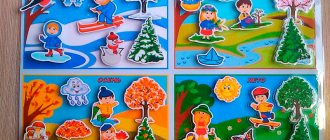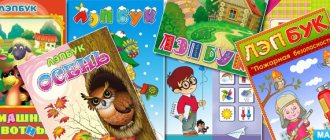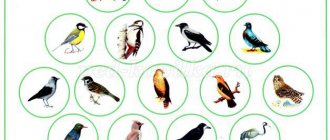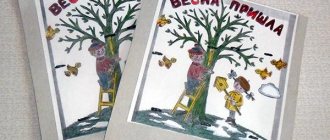Studying music is fun! The best books and manuals for children
Children are very sensitive. They always understand when parents themselves are interested in music and when they are not. Mom often says: “Quickly do the solfeggio assignments.” Do you think a child who also hates this solfeggio will want to study? And if mom says: “What are you studying now? Seventh chords? Did you know that Beethoven uses them so beautifully in the Moonlight Sonata? Don't know "Moonlight Sonata"? So let's listen!"
Of course, you will say that not every parent is a musician and has the time and knowledge. If you studied at a music school (and remember something else), then good. But even if you don’t have the knowledge, it doesn’t matter! We have prepared for you the most interesting books about music, with the help of which it is very easy to interest even the most stubborn!
You might find something from this list useful (almost all books can be downloaded completely free in pdf format):
- “Music Theory for Little Musicians and Their Parents”, author - T.E. Pervozvanskaya
This is both a fairy tale and a textbook that explains musical concepts in a very simple and interesting way.
- “Queen Gamma”, author - E. Poplyanova.
In principle, this author has a lot of good books for beginners that will help a child fall in love with solfeggio.
- “Note ABC”, author N.P. Konchalovskaya
This is a very good book-guide for small and large aspiring musicians
- “The alphabet of music for both preschoolers and primary schoolchildren”, author I.S. Korolkova.
- “Incorrect solfeggio, in which instead of rules there are songs, pictures and different stories!”, author O. Kamozina
A child can read this book on his own, but knowledge of the basics of musical literacy will be required.
- “The ABC of Music in Fairy Tales, Poems and Pictures”, author E. A. Koroleva
This manual is intended for classes with preschoolers (5 and 6 years old), but younger students will also definitely like it. There are a lot of games, poems and stories.
- “Musical education of a child”, authors Lev Madorsky and Anatoly Zak
And this book is needed if you want to understand whether your child should take up music and what needs to be done so that children love and are interested in it.
- “Music from A to Z”, author E. Finkelstein
This is a fairly “old” and well-known book that can still be found in bookstores. Very often, teachers of children's music schools recommend it.
- Manuals by V. Zhilin “How to conduct lessons on playing musical instruments”
His work is based on the K. Orff system, which promotes the formation of creative imagination in a child, instills a love of vocals, music and develops a sense of rhythm. There are very few books by Zhilin on sale.
- “Elementary Theory of Music”, author I. V. Sposobin
And this book is necessary for those who study or want to remember musical literacy.
If you can’t get into the musical theme, but really want to help your child, then give your young musician some time, maybe 2 times a week:
- find out what he is studying
- is he interested
- try playing a music quiz (the questions can be found in the textbooks given above).
To keep interest in music lessons alive, play cartoons with good melodies for your child, for example:
- "Cinderella"
- "Pencil and Eraser"
- "Nutcracker"
- "Ballerina on a Ship"
Examples of homemade tools
As an example, we will give only some of the simplest and most interesting tools. You can change them, come up with your own solutions, etc. The main requirement is that everyone should be interested.
Table. DIY tool options.
| Tool name | Brief description and manufacturing features |
Tambourine | You need to prepare an ordinary wooden hoop that is used for embroidery. This will be the body of the instrument, and the sounds are made by lemonade lids (10 pcs.), which are fixed on metal axes (wire Ø 1 mm). Hard plastic measuring approximately 1.5 x 1.5 cm and electrical tape are used to secure the two parts of the instrument. The hoops are disconnected, and pieces of wire are inserted between them, and metal covers are put on each. There are five pairs in total. Then cardboard or plastic plates are inserted between the individual elements and the entire structure is connected with tape or insulating tape. |
| Panflute | A musical instrument can create not only noise, but also similar sounds. It can be made from cocktail straws, but it is better to find straws with a slightly larger diameter. You will need 7 straws, tape and thick cardboard. Shorten each tube a little, the length of the first should be within 15 cm. Let each child independently experiment with sounds and length. He will really like this, he should understand the dependence of sound on length. When all the tubes make different sounds, fix them on cardboard of the appropriate sizes, the upper ends should be located in the same plane. The cardboard can be painted with various colors, the instrument will become more attractive. Do not forget that the lower ends of the tubes must be sealed, otherwise the instrument will not play. |
Chinese drum | It is made from a tin can, preferably metal. The diameter does not matter; you can use different ones and make entire sets of tools. Plastic lids are put on the jars; instead, you can use a thin but durable polymer. The walls of the drum are pierced, a ribbon is inserted into the holes and tied on both sides with a knot to secure it. |
Hanging bells | The craft is hung outside and makes sounds only in windy weather. For bells, use solid tubes that produce ringing notes when struck. You can fix store-bought bells on a cardboard tube or wooden handle. |
These examples are given only so that you can navigate the different types of homemade tools.
How to make a rain flute
On the topic: methodological developments, presentations and notes
The methodological manual promotes the development of mental processes of memory, attention, and perception of the thought processes of preschoolers. Formation of a holistic picture of the world, development of fine motor skills, sensory.
Musical and didactic games occupy a special place in the musical development of a preschooler. The proposed games are aimed at developing the perception of music, the development of vocal singing, and spatial orientation.
Consultation for educators.
1. Reasons for delayed speech development in children. 2. Tasks. 3. Examples of finger games.
Consultation for educators.
CONSULTATION FOR TEACHERS on the innovative activities of a music director on the topic: “The use of art therapeutic methods and technologies in .
One of the important tasks of the comprehensive development of a child is the education of musical culture. Its foundations are laid in childhood. In this regard, a large place is given to music in kindergartens, &nda.
Discussions.







